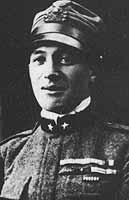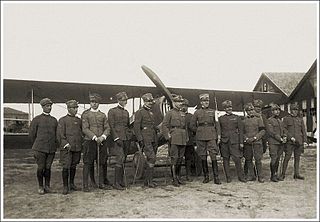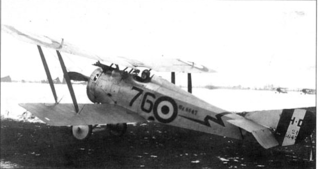Related Research Articles

Count Francesco Baracca was Italy's top fighter ace of World War I. He was credited with 34 aerial victories. The emblem he wore side by side on his plane of a black horse prancing on its two rear hooves inspired Enzo Ferrari to use it on his racing car and later in his automotive company.

Fulco VIII, Prince Ruffo di Calabria, 6th Duke of Guardia Lombarda was an Italian World War I flying ace and senator of the Kingdom from 1934 until his death. He was the father of Paola, Queen of the Belgians.

Flavio Torello Baracchini was an Italian World War I fighter ace credited with 21 confirmed and nine unconfirmed aerial victories. His confirmed victory total ranked him fourth among Italian aces of the war.

Sottotenente Michele Allasia was a World War I fighter ace credited with five aerial victories.
Capitano Giulio Lega was a World War I flying ace credited with five aerial victories. After finishing the war, he completed medical school, and began a near lifelong career caring for the Italian Chamber of Deputies.
CapitanoGuido Masiero was a World War I flying ace credited with five confirmed and ten unconfirmed aerial victories. He was a prewar lancer who used his civilian engineering expertise to wrangle a transfer to aviation duty.
Tenente-colonnello Alessandro Resch was an Italian World War I flying ace credited with five confirmed aerial victories. After surviving World War I, he would become a pioneering airline captain, flying 500,000 miles between 1928 and 1935. He would return to the Italian Air Force as a major in 1935, rising to tenente-colonnello by 1939. His participation in World War II is unknown.
Tenente Giovanni Sabelli was an Italian World War I flying ace credited with five aerial victories. At the start of World War I, he was already an experienced combat pilot.

Tenente ColonnelloAlessandro Buzio was an Italian World War I flying ace credited with six aerial victories, four of them shared.

Sergente Cesare Magistrini began his lengthy aviation career as a World War I flying ace credited with six confirmed and four unconfirmed aerial victories.
Tenente Luigi Olivi (1894–1917) was an Italian World War I flying ace credited with six aerial victories. He won two awards of the Silver Medal for Military Valor and was killed in action.

Tenente Giorgio Pessi was a World War I flying ace born in Austria-Hungary who chose to fly for Italy. He was credited with six aerial victories.

TenenteMario Fucini was a World War I flying ace who claimed credit for 13 aerial victories during the war; seven of these were confirmed in 1919.
Tenente Gastone Novelli was a World War I flying ace credited with eight aerial victories.

Tenente colonnelloAlvaro Leonardi was a World War I Sottotenente from Italy and a flying ace credited with eight aerial victories.
SergenteGiovanni Nicelli was an Italian World War I flying ace. He was credited with eight or nine confirmed aerial victories, and died in service to his nation on 5 May 1918.
Flaminio Avet was a World War I flying ace credited with eight aerial victories. Although born in Nice, France, he served in the Italian military as Italy entered World War I. After a transfer from Lancers to aviation, he trained as a pilot. He began his aerial combat career on 27 November 1918, and would stake a dozen victory claims, eight of which would be verified. He ended the war having won the Silver Medal for Military Valor three times. He returned to Nice postwar, and died there on 21 August 1928.
CapitanoErnesto Cabruna (1889–1960) was a professional soldier who became a World War I flying ace credited with eight aerial victories. He served in Italy's military police, beginning in 1907. After service in Libya and Rhodes, he received a Bronze Medal for Military Valor a year after Italy's involvement in World War I began. He turned to aviation, became a pilot, and as such earned his first Silver Medal for Military Valor at the end of 1917.

81a Squadriglia was an Italian fighter squadron raised in March 1917 that served through the end of World War I. One of its aces, Flavio Baracchini, would become the first awardee of the Gold Medal for Military Valor. The squadron would be credited with 34 aerial victories, and suffer four dead. It ended the war with 28 aircraft on strength.

Squadriglia 91a was one of the later fighter squadrons that the Italian Army created, on 1 May 1917. Because it drew an experienced cadre of pilots from pre-existing 70a Squadriglia, the squadron scored 14 victories within its first month of flying combat. As a result, it became known as "the squadron of aces". The new unit was immediately drawn into the ongoing Battles of the Isonzo in northern Italy. In September 1917, the squadron would serve as test pilots of the universally condemned SIA 7 multipurpose aircraft.
References
- Franks, Norman; Guest, Russell; Alegi, Gregory. Above the War Fronts: The British Two-seater Bomber Pilot and Observer Aces, the British Two-seater Fighter Observer Aces, and the Belgian, Italian, Austro-Hungarian and Russian Fighter Aces, 1914–1918: Volume 4 of Fighting Airmen of WWI Series: Volume 4 of Air Aces of WWI. Grub Street, 1997. ISBN 1-898697-56-6, ISBN 978-1-898697-56-5.
- Guttman, Jon. SPAD XII/XIII aces of World War I. Osprey Publishing, 2002. ISBN 1841763160, 9781841763163.